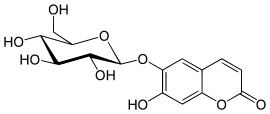Aesculin
Aesculin, also called æsculin or esculin, is a coumarin glucoside that naturally occurs in the trees horse chestnut (Aesculus hippocastanum),[1] California buckeye (Aesculus californica),[2] prickly box (Bursaria spinosa), and daphnin (the dark green resin of Daphne mezereum). It is also found in dandelion coffee.
 | |
| Names | |
|---|---|
| IUPAC name
7-hydroxy-6-{[(2S,3R,4S,5S,6R)-3,4,5-trihydroxy- 6-(hydroxymethyl)-2-tetrahydropyranyl]oxy}-2-chromenone | |
Other names
| |
| Identifiers | |
3D model (JSmol) |
|
| ChEBI | |
| ChEMBL | |
| ChemSpider | |
| DrugBank | |
| ECHA InfoCard | 100.007.744 |
| EC Number |
|
| KEGG | |
PubChem CID |
|
| UNII | |
CompTox Dashboard (EPA) |
|
| |
| |
| Properties | |
| C15H16O9 | |
| Molar mass | 340.282 g/mol |
Except where otherwise noted, data are given for materials in their standard state (at 25 °C [77 °F], 100 kPa). | |
| Infobox references | |
Medical uses
As medication, aesculin is sometimes used as a vasoprotective agent.[3]
Aesculin is also used in a microbiology laboratory to aid in the identification of bacterial species (especially Enterococci and Listeria). In fact, all strains of Group D Streptococci hydrolyze æsculin in 40% bile.
Aesculin hydrolysis test
Aesculin is incorporated into agar with ferric citrate and bile salts (bile aesculin agar).[4] Hydrolysis of aesculin forms aesculetin (6,7-dihydroxycoumarin) and glucose. Aesculetin forms dark brown or black complexes with ferric citrate, allowing the test to be read.
The bile aesculin agar is streaked and incubated at 37 °C (99 °F) for 24 hours. The presence of a dark brown or black halo indicates that the test is positive. A positive test can occur with Enterococcus, Aerococcus, and Leuconostoc. Aesculin will fluoresce under long wave ultraviolet light (360 nm) and hydrolysis of aesculin results in loss of this fluorescence.
Enterococcus will often flag positive within four hours of the agar being inoculated.

Warnings
Aesculin ingestion can produce stomachache, spasms, diarrhea, disorientation and even death at high doses.
References
- "Plant poisons: Aesculin". University of Bristol. Retrieved July 17, 2018.
- C. Michael Hogan (2008) California Buckeye: Aesculus californica, GlobalTwitcher.com, N. Stromberg ed.
- Esculin. Drugs.com. Retrieved 11 June 2016.
- National Standard Methods MSOP 48 (Bile aesculin agar) and BSOPTP 2 (Aesculin hydrolysis test (UK))